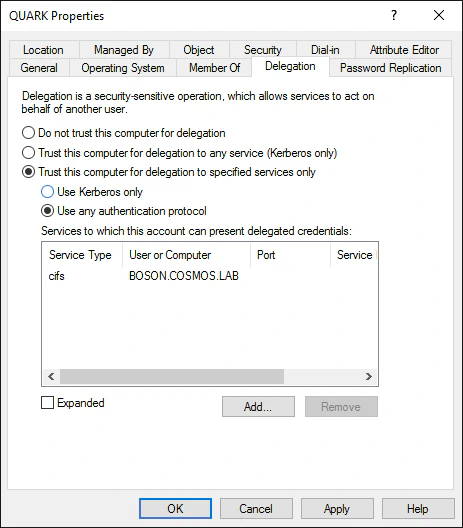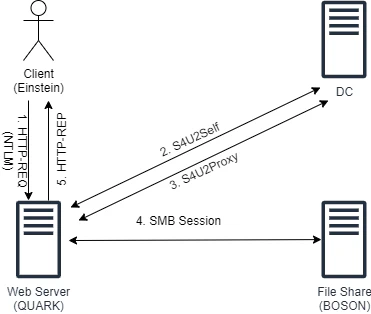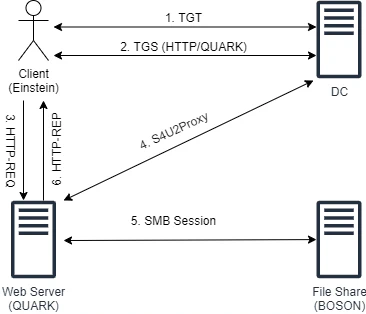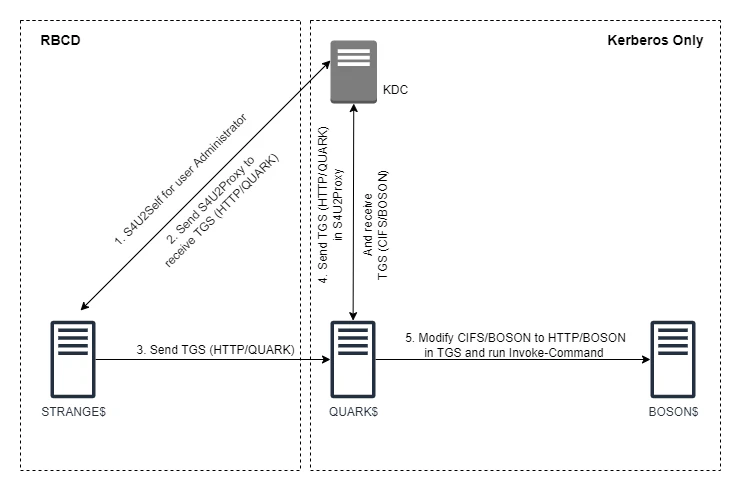Attacking Kerberos: Constrained Delegation
In the last blog, we discussed Unconstrained Delegation in detail. We also saw how dangerous Unconstrained Delegation can get. Unconstrained Delegation was the very first implementation of Delegations, introduced back in Windows Server 2000. It wasn’t an ideal solution and Microsoft soon came with a better alternate called Constrained Delegation in Server 2003.
S4U Extension
Major problem with Unconstrained Delegation was that we had to send TGTs along with our TGS so that the service can request TGS to other services on our behalf. How about if the service would be able to request TGS to other services using the TGS it has received from the client? That would eliminate the need for sending TGTs. But, if we think about how Kerberos authentication works, we do need TGT to request a TGS from KDC. This is where an extension to Kerberos was introduced. This extension allowed KDC to issue a TGS using a valid TGS also. This extension is called Service-for-User (S4U), and it makes Constrained Delegation possible. S4U uses two kind of requests- S4U2Proxy and S4U2Self. Let’s cover both of these.
S4U2Proxy
S4U2Proxy request is pretty much what I’ve mentioned above. It allows a service to send a valid TGS to KDC and request TGS to another service. If it sounds bit confusing as of now, don’t worry, there’s an example below in Traffic Analysis section that would explain the whole flow.
S4U2Self
So, as I said, S4U2Proxy send a valid TGS to request another TGS. But what if the user is not using Kerberos to authenticate? In that case, the service wouldn’t get the TGS from the client. This is where S4U2Self would chip in. S4U2Self allows a service to request a TGS to itself. So, when a client authenticates to the service using, say, NTLM authentication, what the service will do is first send S4U2Self request to get TGS to itself. Then use this TGS with S4U2Proxy to request TGS to another service. Again, if it all sounds confusing the example in Traffic Analysis section would help.
Kinds of Constrained Delegation
From the discussion above, we can somewhat get an idea that there are two kind of Constrained Delegations possible- one where we have Kerberos Authentication and only need S4U2Proxy and one where there is NTLM Authentication and we have to use both S4U2Self and S4U2Proxy. The first kind is called Kerberos Only and the second kind is called Protocol Transition, pretty self-explanatory names. Let’s cover both of these. Small point to note here would be that, like Unconstrained Delegation, Constrained Delegation also requires a user with SeEnableDelegation to set it up on any account.
Protocol Transition

The image here shows how the configuration would look like with Protocol Transition enabled. Here we can see that the names of the services QUARK$ is allowed to delegate to is already listed, it would get stored in msDS-AllowedToDelegateTo attribute of QUARK$. Additionally, when setting Protocol Transition for an account, TRUSTED_TO_AUTH_FOR_DELEGATION UAC setting also gets set. This flag is an indication, as we will see in the example below, to the KDC that the account supports S4U2Self requests.
Traffic Analysis


Step 1: Client authenticates to QUARK$ using NTLM.
Step 2: QUARK$ sends S4U2Self request to KDC, requesting TGS to itself. Interesting note here is that only the name of client (Einstein) would be part of this request, so it is possible to send a S4U2Self request for any arbitrary user.
Step 3: KDC would notice QUARK$ has TRUSTED_TO_AUTH_FOR_DELEGATION set and accept the S4U2Self request. It would issue a TGS which has Forwardable flag set. Another thing to note here is that without TRUSTED_TO_AUTH_FOR_DELEGATION flag, KDC would still issue TGS, but without Forwardable flag.
Step 4: QUARK$ sends S4U2Proxy request with TGS it got from S4U2Self and asks for TGS to CIFS/BOSON.
Step 5: KDC, upon receiving TGS request from QUARK$, would verify if QUARK$ is allowed to delegate to CIFS/BOSON or not (by checking msDC-AllowedToDelegateTo parameter). Since QUARK$ is allowed to, KDC would return TGS to CIFS/BOSON in response.
Step 6: The TGS returned by S4U2Proxy would then be used to access the remote share on BOSON$. Yet another thing to note here is that the SPN (CIFS/BOSON) is written in plaintext in the TGS. Thus, it can be modified to authenticate to other services on BOSON$.
Abusing Protocol Transition
While analyzing the traffic, we noticed two things:
- Client name in S4U2Self request can be arbitrary. KDC essentially trusts the name of client provided in S4U2Self.
- The SPN value in TGS are plaintext and can be substituted easily.
To abuse Protocol Transition, we will be utilizing both of these observations. But, for now, let’s see how do we actually find accounts that support Constrained Delegation. We can use PowerView for that:
Get-DomainComputer -TrustedToAuth -Properties cn,msds-allowedtodelegateto
Now that we know which accounts we have to target, we need to know how to craft S4U2Self and S4U2Proxy requests with the parameters we want. Rubeus has s4u module for that. Here’s the command:
Rubeus s4u /impersonateuser:Administrator /user:QUARK$ /rc4:<NTLM> /msdsspn:cifs/BOSON /altservice:http /ptt
where:
impersonateuser: The client name we want to requests TGS foruser: Machine account that has Constrained Delegation enabled (can be user account also)rc4: NTLM hash of that machine accountmsdsspn: SPN to whichuseris allowed to delegate toaltservice: Alternate services for which we want the TGS
Basically, what we will do here is first send a S4U2Self request to KDC with username Administrator. Since the KDC trusts the username provided in S4U2Self requests, it will return a valid TGS of user Administrator. And since QUARK$ has Protocol Transition Constrained Delegation enabled, the returned TGS would also have Forwardable flag. This TGS would then be used in S4U2Proxy request next. Again, the TGS is of user Administrator, so the ticket to CIFS/BOSON returned by KDC would also be of user Administrator. Now, recall that the SPN value in TGS are in plaintext. So, we would modify the CIFS/BOSON to, for instance, HTTP/BOSON that would allow us to use Invoke-Command or maybe to LDAP/BOSON if BOSON$ was DC which would have allowed us to DCSync.
Here’s a video that will demo this attack. In the video, we first check for accounts that have Constrained Delegation enabled. We find QUARK$ is allowed to delegate to CIFS/BOSON. We then assume SYSTEM access on QUARK$. After that, we try to run a command on BOSON to verify that we already don’t have any such rights over it. Then we extract NTLM hash of the QUARK$ account. Finally, we run Rubeus with s4u command to request the TGS CIFS/BOSON for user Administrator and then forge the SPN to HTTP/BOSON in order to run commands using WinRM.
Kerberos Only
Now that we have covered the Protocol Transition, it’s time to cover a much simpler kind of Constrained Delegation- Kerberos Only. Configuration for Kerberos is pretty much the same as Protocol Transition, we just select ‘Use Kerberos only’ radio button instead of ‘Use any authentication protocol’.
Like Protocol Transition, the list of services QUARK$ is allowed to delegate to will be saved in msDS-AllowedToDelegateTo attribute. But, unlike Protocol Transition, Kerberos Only won’t set the TRUSTED_TO_AUTH_FOR_DELEGATION UAC flag.
I won’t deep dive into the traffic analysis for Kerberos Only here. The traffic analysis of protocol transition and the diagram below should be sufficient enough to explain what would happen.


Abusing Kerberos Only
Pre-requisites: To understand this attack, you first need to understand the attacks for both Protocol Transition and Resource Based Constrained Delegation.
Kerberos Only is the most secure form of Delegation we have. To abuse this, we would actually be using an indirect method that exploits Resource Based Constrained Delegation first.
What do you need? You need SYSTEM access on a machine that has Kerberos Only Constrained Delegation set on the target machine. In our example below, we have SYSTEM on QUARK$ and it has delegation set for CIFS/BOSON service.
How the attack path would look?
- We will first add a new machine in domain.
STRANGE$in our example. - We will add
STRANGE$inmsDS-AllowedToActOnBehalfOfOtherIdentityattribute ofQUARK$. (If you didn’t get what we did here, you probably need to go through RBCD first) - Abuse RBCD using
STRANGE$onQUARK$. This will give us a forwardable TGS forQUARK$. - Use that TGS as proof of authentication in S4U2Proxy for
BOSON$.
If it all sounded pretty complex then you’re not alone, it really is. I’ll try to explain as best as I could.
So, Kerberos Only has one major requirement- a valid forwardable TGS to be used in S4U2Proxy requests. If we recall the abuse case of Protocol Transition, we were able to send the S4U2Self request to get a valid TGS but here in case of Kerberos Only, that TGS won’t have Forwardable flag set. Question is when do we get a forwardable TGS? When a legit user requests TGS from KDC using its TGT. And in case of S4U2Proxy requests too.
Looking back at our example, QUARK$ is the machine we have SYSTEM over and that has delegation set to CIFS/BOSON. As attacker, what we want to do is to run Invoke-Command over BOSON$ as Administrator. Kerberos Only says that for S4U2Proxy request to CIFS/BOSON, we would need a valid TGS for XYZ/QUARK (XYZ meaning any service on QUARK$) of user Administrator.
Now, we can get a forwardable TGS for XYZ/QUARK if another resource is trying to either authenticate to or delegate to XYZ/QUARK. This is where we will use our RBCD trick. What we will do is create a machine STRANGE$. Then, set QUARK$ to allow RBCD from STRANGE$. We will then use STRANGE$ to delegate as Administrator into QUARK$. That way, we will get a valid forwardable TGS of Administrator (result of S4U2Proxy of RBCD). We will then use this TGS in the S4U2Proxy request to receive CIFS/BOSON TGS. This diagram will explain it better:

Now comes our demo. This demo pretty much does the exact same thing we described above. First we will add the machine STRANGE$. Then we will set RBCD on QUARK$ and verify if the RBCD is set correctly. Then we will RBCD from STRANGE$ to QUARK$ to get a valid TGS. Then use that TGS to perform a S4U2Proxy request to BOSON$.
Here’s the script I’ve used in the demo:
Further Reading
Related Posts
Attacking Kerberos: Unconstrained Delegation
So we are going to talk about Unconstrained Delegation in this blog. I have already covered a small introduction to Delegations and the Kerberos concepts you’d need to understand it in an introduction blog.
Read moreIntroduction to Active Directory Delegations
I spent past few months working on Cybernetics lab from HTB. Awesome labs, thoroughly enjoyed it, tons of things to learn.
Read moreAttacking Kerberos: Resource Based Constrained Delegation
Now that we are done with Unconstrained and Constrained Delegations, it is time for the finale. In this blog we’ll discuss Resource Based Constrained Delegation (RBCD).
Read more